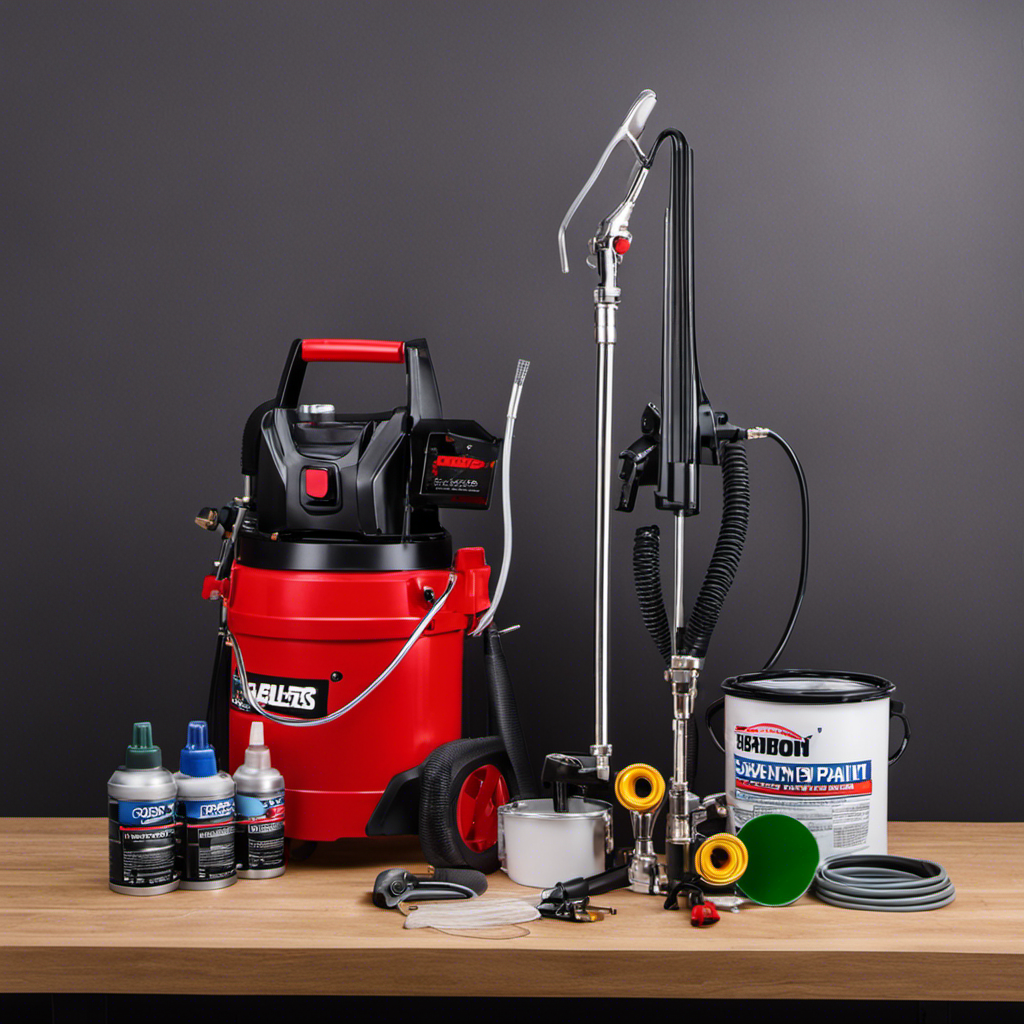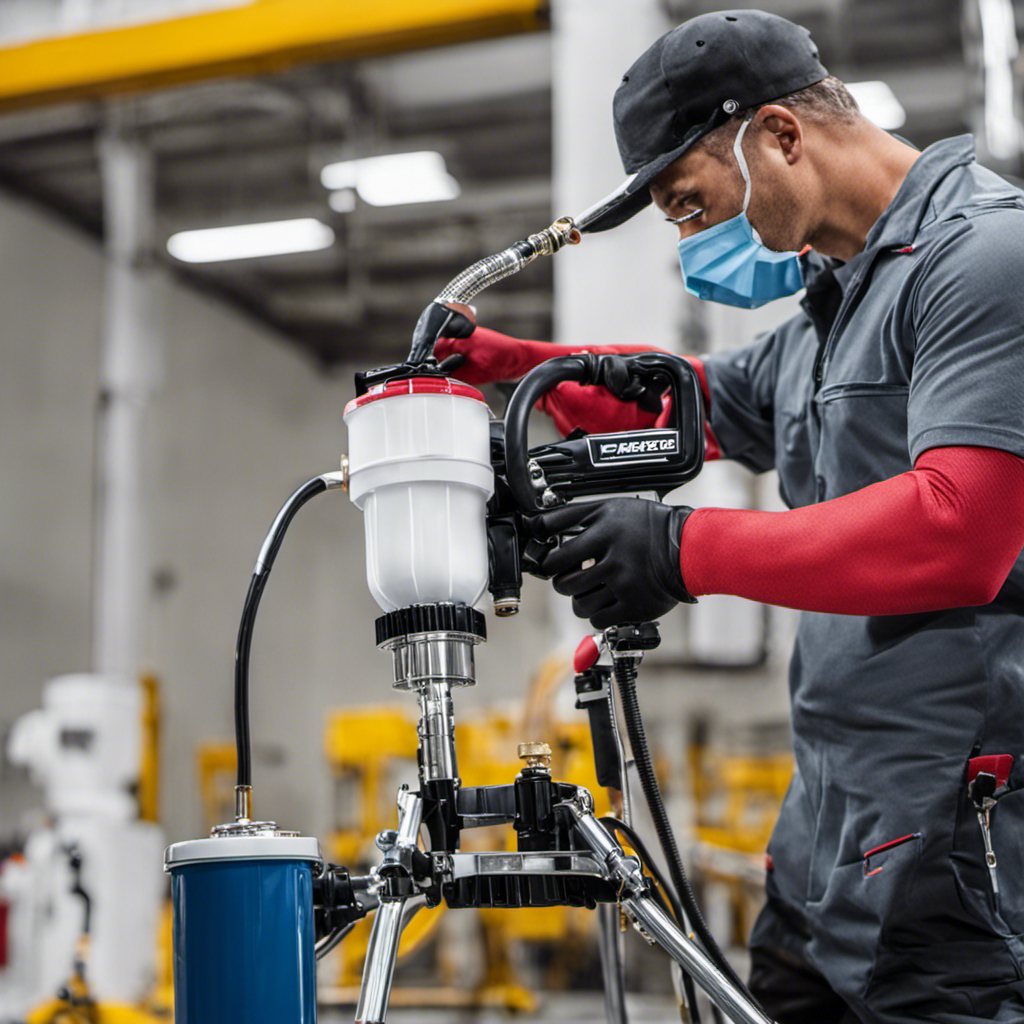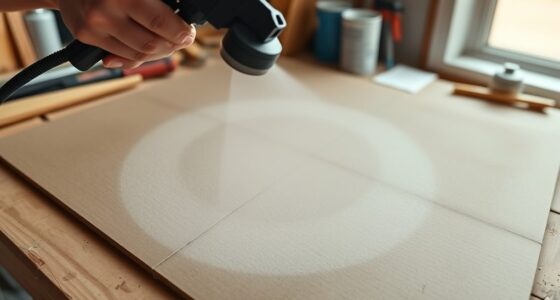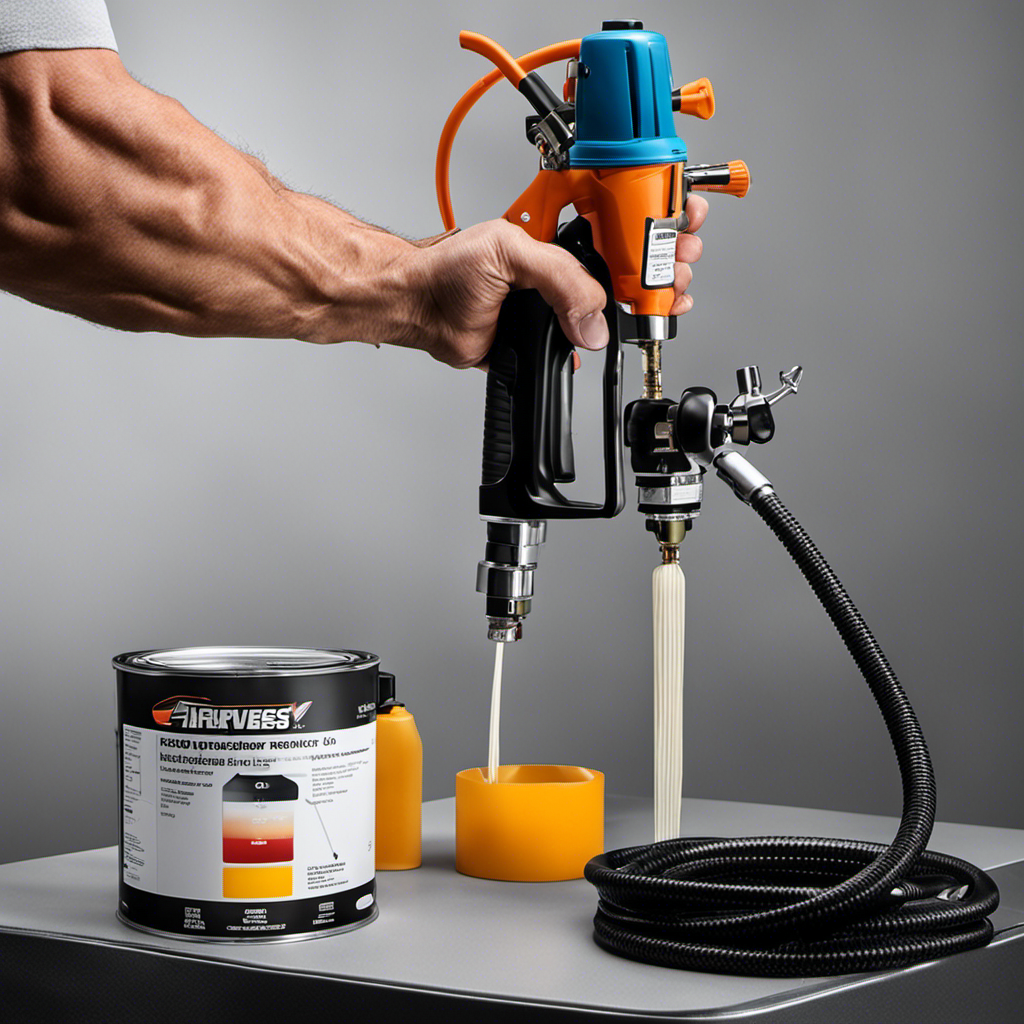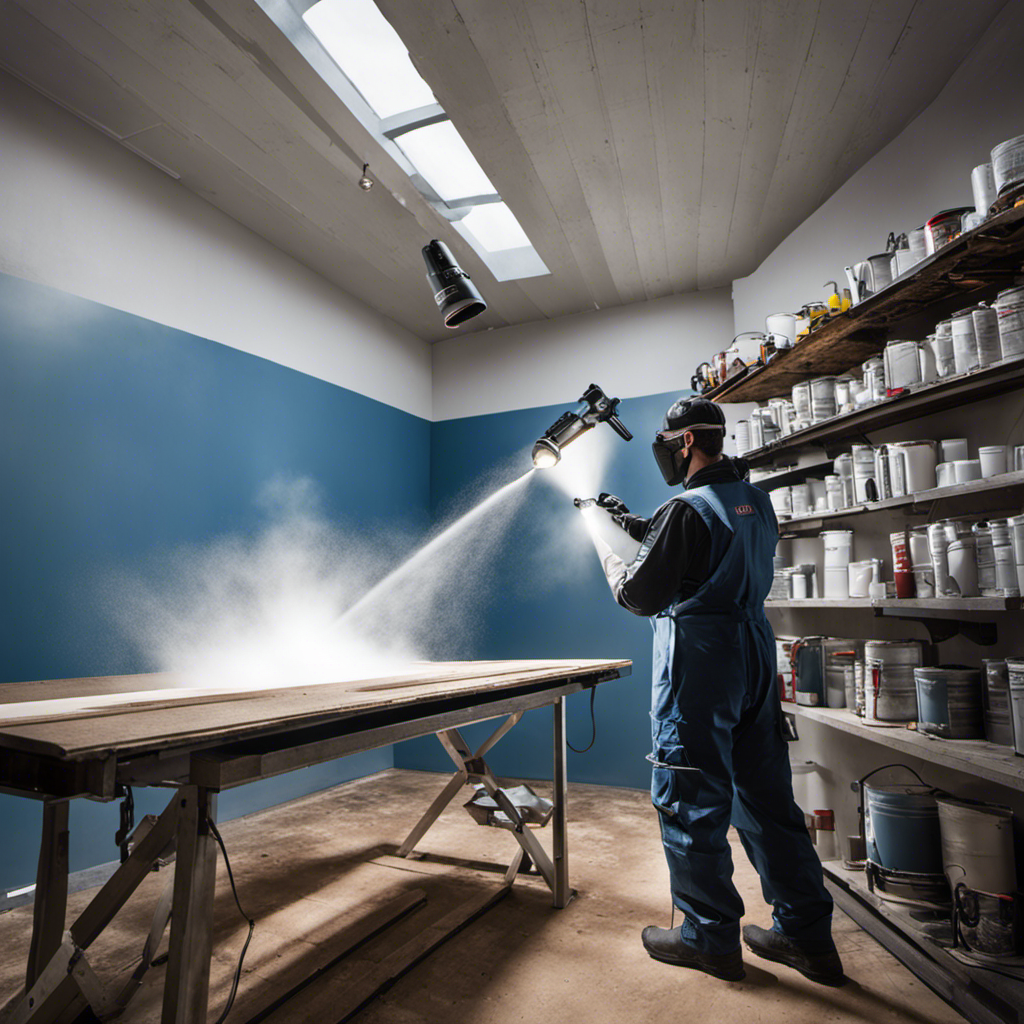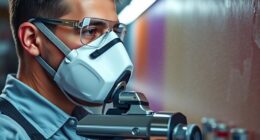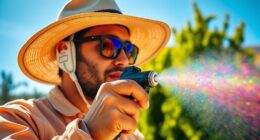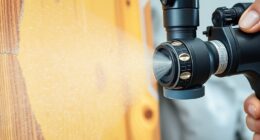As a person who has dedicated a lot of time to DIY projects, I have come to appreciate the incredible effectiveness of an airless paint sprayer. It feels like I wield a magical tool in my hands that effortlessly revitalizes worn-out walls and surfaces, giving them a whole new look.
But before you embark on your painting adventure, there are a few key essentials you’ll need to ensure a successful outcome. From safety equipment to the right paint and accessories, this article will guide you through everything you need to use with an airless paint sprayer.
Let’s dive in and get your project started with confidence!
Key Takeaways
- Respirator and goggles are essential safety equipment for using an airless paint sprayer.
- The paint sprayer consists of a spray gun, hose, motor, filters, and tip, which work together to deliver paint onto the surface.
- Different types of paint can be used with an airless paint sprayer, including latex paint, oil-based paint, stain, primer, and specialty paints.
- Proper paint preparation, such as straining, mixing, cleaning the surface, and adjusting pressure, is crucial for achieving a flawless finish with the sprayer.
Safety Equipment
You should always wear the appropriate safety equipment when using an airless paint sprayer. Safety should be your top priority to prevent any accidents or health risks.
One essential piece of safety equipment is a respirator. This will protect your respiratory system from inhaling any paint fumes or particles that could be harmful.
Goggles are also crucial to shield your eyes from any splatters or overspray. It’s important to choose goggles that provide a snug fit and have adequate ventilation to prevent fogging up.
By wearing a respirator and goggles, you’ll be ensuring your safety while operating the airless paint sprayer.
Now that we’ve covered the necessary safety equipment, let’s move on to the next section about the paint sprayer itself.
Paint Sprayer
The recommended equipment for operating an airless paint sprayer includes a spray gun, hose, and motor.
To give you a clear picture of how a paint sprayer works, here are five key components you’ll need:
-
Spray Gun: The spray gun is the tool that delivers the paint onto the surface. It has a trigger to control the flow of paint and a nozzle to adjust the spray pattern.
-
Hose: The hose connects the spray gun to the motor. It carries the paint from the motor to the gun, allowing for easy maneuverability.
-
Motor: The motor powers the paint sprayer and creates the necessary pressure to atomize the paint for smooth application.
-
Filters: Paint sprayers usually have filters to prevent debris and impurities from clogging the spray gun or nozzle.
-
Tip: The tip, also known as the nozzle, determines the size and shape of the spray pattern. It can be interchangeable to achieve different results.
Now that you have an understanding of the paint sprayer equipment, let’s dive into the world of paint application.
Paint
When it comes to using a paint sprayer, it’s important to choose the right paint type for optimal results. Different sprayers may require different types of paint, such as latex or oil-based.
Additionally, proper paint preparation is crucial for achieving a smooth finish. This involves cleaning and priming the surface, as well as thinning the paint if necessary.
Paint Types for Sprayer
To achieve the best results with an airless paint sprayer, it’s important to consider the paint types that can be used. Here are some options to consider:
- Latex Paint: This type of paint is water-based and dries quickly, making it ideal for indoor projects.
- Oil-based Paint: This paint provides a durable finish and is commonly used for outdoor projects.
- Stain: If you’re looking to enhance the natural beauty of wood, stains are a great option.
- Primer: Applying a primer before painting can improve adhesion and create a smooth surface.
- Specialty Paints: From metallic finishes to textured coatings, there are specialty paints available for unique projects.
When using an airless paint sprayer, it’s essential to ensure proper sprayer maintenance and practice effective paint application techniques. By doing so, you can achieve professional-looking results and save time and effort in the process.
Now, let’s move on to the next section about proper paint preparation.
Proper Paint Preparation
For the best results, make sure you properly prepare the paint before using an airless sprayer. Proper paint preparation is crucial for achieving a smooth and professional finish.
Before loading the paint into the sprayer, it is important to strain it to remove any impurities or debris that could clog the sprayer nozzle. This can be done using a mesh strainer or a paint filter.
Additionally, the paint should be thoroughly mixed to ensure consistent color and texture throughout the application process.
Surface preparation is equally important. The surface should be clean, dry, and free of any dirt, dust, or grease. It is also recommended to sand the surface lightly to create a smooth and even base for the paint.
By following these paint application techniques and surface preparation steps, you can ensure a flawless finish with your airless sprayer.
To further optimize your paint application, it is important to adjust the pressure regulator on your airless sprayer.
Pressure Regulator
Make sure you adjust the pressure regulator on the airless paint sprayer to achieve the desired spray pattern. The pressure control is essential for ensuring a smooth and even application of paint.
Here are some key factors to consider when adjusting the pressure regulator:
-
Nozzle size: Choose the appropriate nozzle size for the type of paint you’re using and the desired spray pattern.
-
Pressure setting: Start with a low pressure setting and gradually increase it until you achieve the desired spray pattern.
-
Distance from the surface: Maintain a consistent distance between the sprayer and the surface to ensure an even application.
-
Paint viscosity: Thicker paints may require higher pressure settings, while thinner paints may need lower pressure.
-
Test spray: Always perform a test spray on a scrap surface to check the spray pattern and make any necessary adjustments.
With the pressure regulator properly adjusted, you can now move on to using an extension pole for those hard-to-reach areas.
Extension Pole
Grab the extension pole to easily reach those difficult areas while painting.
An extension pole is a versatile tool that can greatly enhance your painting technique. It allows you to extend your reach, making it easier to paint high ceilings, walls, and even the exterior of your home.
The extension pole attaches securely to the handle of your paint sprayer, giving you better control and stability while painting. This tool is especially useful when working on large projects or areas that are hard to reach, such as behind furniture or in tight corners.
By using an extension pole, you can save time and effort by avoiding the need for ladders or scaffolding.
Now, let’s move on to the next important component of an airless paint sprayer: the tip or nozzle.
Tip or Nozzle
The tip or nozzle is an essential component of an airless paint sprayer that determines the spray pattern and flow rate of the paint. It affects the quality and efficiency of the paint application. Here are five key points to consider about the tip or nozzle:
-
Tip Size: The size of the tip determines the paint flow rate and the thickness of the paint application. Smaller tips are suitable for thinner paints, while larger tips are better for thicker paints.
-
Spray Pattern: The tip determines the shape and width of the spray pattern. It can be adjusted to produce a narrow or wide pattern, depending on the surface being painted.
-
Material Compatibility: Different tips are designed for specific materials, such as latex or oil-based paints. It is important to choose a tip that is compatible with the type of paint being used.
-
Wear and Tear: The tip can wear out over time due to the high-pressure paint flow. Regular inspection and replacement of worn-out tips are necessary to ensure optimal performance.
-
Cleaning: After each use, the tip should be thoroughly cleaned to remove any dried paint residue. This prevents clogging and ensures a consistent paint flow.
With the tip or nozzle properly set up, the next crucial component to consider is the hose.
Hose
Once you’ve chosen the right tip or nozzle, it’s important to ensure that the hose is properly connected and functioning. Hose maintenance is crucial for the smooth operation of an airless paint sprayer.
Begin by inspecting the hose for any signs of wear or damage. Replace any worn or damaged parts immediately to avoid leaks or interruptions in paint flow.
Additionally, it’s important to choose the right hose length for your needs. Longer hoses can be more cumbersome to maneuver, but they allow for greater reach. On the other hand, shorter hoses are more manageable but may require frequent repositioning. Consider your preference and the size of the project before selecting the appropriate hose length.
Now, let’s move on to the next section and discuss the importance of using a suitable cleaning solution for your airless paint sprayer.
Cleaning Solution
To effectively clean your equipment, make sure you have the appropriate cleaning solution ready. Cleaning an airless paint sprayer is essential for its proper maintenance and longevity. Here are some maintenance tips and a few items you’ll need:
- Cleaning Solution: A specialized cleaning solution specifically designed for airless paint sprayers is crucial for effective cleaning.
- Bucket: A sturdy bucket is necessary to mix and hold the cleaning solution.
- Brushes: Use brushes with stiff bristles to scrub away any paint residue or debris.
- Safety Equipment: Don’t forget to wear gloves and safety goggles to protect yourself during the cleaning process.
- Water Source: You’ll need access to a water source to rinse off the equipment after cleaning.
Now that your equipment is clean, let’s move on to the next step: preparing drop cloths to protect the surrounding area.
Drop Cloths
Now that your equipment is clean, it’s important to prepare drop cloths to protect the surrounding area. Drop cloths are an essential tool in painting techniques as they help prevent paint splatters and drips from damaging floors, furniture, or other items in the vicinity.
Before starting any painting project, it is crucial to ensure that the surface is properly prepared. This involves cleaning, sanding, and priming the area to ensure a smooth and even finish. Once the surface is ready, lay down drop cloths to catch any paint that may accidentally fall or splatter. These protective coverings can be made of various materials such as canvas or plastic and come in different sizes to suit your needs.
Now that the drop cloths are in place, it’s time to grab your stir stick and prepare the paint.
Stir Stick
When it comes to achieving a smooth and professional-looking paint job, the importance of paint consistency cannot be overstated. Having the right consistency ensures that the paint flows evenly and adheres properly to the surface.
In order to achieve the perfect consistency, there are a few mixing technique tips that can be helpful. First, stirring the paint in a figure-eight motion can help to evenly distribute the pigments and binders. This motion also helps to prevent air bubbles from forming in the paint.
Second, gradually adding small amounts of water or thinner can help to adjust the consistency of the paint. This is especially useful if the paint is too thick and needs to be thinned out. It’s important to add the water or thinner slowly, stirring the paint as you go, until you reach the desired consistency.
Lastly, choosing the right stir stick is crucial for effectively mixing the paint. Opting for a sturdy stick that is long enough to reach the bottom of the paint can and has a flat edge for scraping the sides will make the mixing process much easier and more efficient.
Paint Consistency Importance
Make sure you’re using the correct paint consistency with your airless paint sprayer to achieve smooth and even coverage. The paint consistency plays a crucial role in the success of your paint application and the drying process.
Here are five important things to keep in mind when it comes to paint consistency:
-
Thinning: Depending on the type of paint and the manufacturer’s recommendations, you may need to thin the paint before using it in the sprayer.
-
Testing: Always test the paint consistency before starting your project to ensure it flows smoothly through the sprayer without clogging or spitting.
-
Adjusting: If the paint is too thick, add small amounts of water or paint thinner until you achieve the desired consistency.
-
Straining: To avoid clogs and uneven spray patterns, strain the paint before pouring it into the sprayer.
-
Mixing: Stir the paint thoroughly to ensure an even consistency and eliminate any lumps or clumps.
Now, let’s move on to some mixing technique tips for optimal results.
Mixing Technique Tips
To achieve optimal results, it’s important to follow proper mixing techniques when preparing your paint for application. Start by gathering the necessary mixing tools, such as a stir stick or a paint mixer attachment for a power drill. These tools will help you thoroughly blend the paint and ensure a consistent color and texture.
When mixing, pay attention to the paint viscosity, which refers to how thick or thin the paint is. If the paint is too thick, it may be difficult to spray evenly, while if it is too thin, it may run or drip. By properly mixing the paint, you can adjust the viscosity to the desired level.
Now, let’s move on to choosing the right stick for the job.
Choosing the Right Stick
Ensure you have the right stick by checking its length and material. A proper paint stick is essential for effective paint mixing. Here are five key factors to consider when choosing the right stick:
- Length: The stick should be long enough to reach the bottom of the paint can, ensuring thorough mixing.
- Material: Opt for a sturdy stick made of wood or plastic, as these materials are durable and resistant to chemical reactions.
- Shape: Look for a stick with a flat end, allowing you to scrape the sides and bottom of the can effectively.
- Graduations: Some sticks have measurement markings, making it easier to measure precise amounts of paint and mix ratios.
- Ergonomics: Consider a stick with a comfortable grip to reduce fatigue during prolonged mixing sessions.
Frequently Asked Questions
Can I Use Any Type of Paint With an Airless Paint Sprayer?
Yes, you can use various types of paint with an airless paint sprayer. However, it is best to use paints that are specifically labeled as suitable for airless sprayers. Follow recommended practices for optimal results.
Do I Need to Wear a Mask When Using an Airless Paint Sprayer?
Should I wear a mask when using an airless paint sprayer? Yes, for the love of your lungs! And don’t forget gloves to protect your hands from paint splatters. Opt for long sleeves and pants too, because fashion and safety go hand in hand.
How Often Should I Clean the Tip or Nozzle of an Airless Paint Sprayer?
To maintain the longevity of an airless paint sprayer and prevent clogs in the tip or nozzle, it is important to regularly clean the tip. I recommend cleaning it after each use for optimal performance.
Can I Use an Extension Pole With Any Type of Airless Paint Sprayer?
Yes, you can use an extension pole with most airless paint sprayers. It allows you to reach high places easily. However, be aware that using an extension pole may require different spraying techniques for optimal results.
What Safety Precautions Should I Take When Using a Pressure Regulator With an Airless Paint Sprayer?
When using a pressure regulator with an airless paint sprayer, it’s important to take safety measures. Pros include better control and reduced overspray, but cons include potential pressure loss and additional equipment needed.
Conclusion
In conclusion, when using an airless paint sprayer, it is essential to have the right equipment to ensure a smooth and efficient painting process.
Safety equipment, like goggles and gloves, will protect you from any potential hazards.
The paint sprayer itself is the main tool needed, along with paint and a pressure regulator to control the flow.
An extension pole is useful for reaching high areas, while a hose allows for easy maneuverability.
Don’t forget a cleaning solution to maintain the sprayer’s longevity.
Lastly, drop cloths and a stir stick will help keep your workspace clean and organized.
As they say, ‘preparation is key,’ and having these items ready will ensure a successful painting experience.
Drenched in creativity and armed with a fountain pen, Isolde weaves words as gracefully as a painter strokes their canvas. A writer for Paint Sprayer Zone, her passion for colors, textures, and spaces finds a harmonious blend with her profound knowledge of painting tools and techniques.
Having grown up in a family of artists, Isolde’s tryst with paints began early. While her relatives expressed themselves on canvas, Isolde found her medium in words. She dedicated herself to chronicling the world of painting, understanding the nuances of each tool, and the artistry behind every spritz of a paint sprayer.
